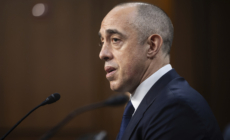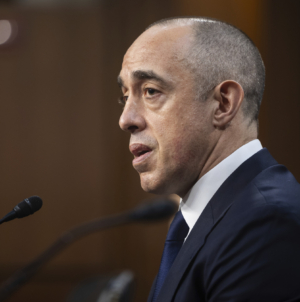-
These Republican Senators Voted Against Emil Bove’s Judicial Confirmation - 9 mins ago
-
Feds move to drop charges in cases after Trump re-ups L.A. prosecutor - 26 mins ago
-
Senate Confirms Susan Monarez as C.D.C. Director - 42 mins ago
-
Lakers’ Luka Doncic Trolls Mavericks After Viral Body Transformation - 44 mins ago
-
‘We’ll see you in court:’ L.A. County wants to bar ICE agents from concealing identity - about 1 hour ago
-
Oscar Piastri Joins Hamilton and Verstappen In Major Achievement - about 1 hour ago
-
Grassley Spurns Whistle-Blowers in Bove Confirmation Fight - about 1 hour ago
-
Tasmanian devils arrive at L.A. Zoo: Danny Zuko and Crush have ferocious bite, bad table manners - 2 hours ago
-
Jeremy Clarkson Slams the FIA Over Belgian Grand Prix Delayed Start - 2 hours ago
-
N.Y.C. Mass Shooting Was Nearly Impossible to Prevent, Experts Say - 2 hours ago
Despite new sales tax to reduce homelessness, LAHSA cuts back an effective path to housing
When people walked into the Downtown Women’s Center in Skid Row seeking help, the organization often turned to a lifeline.
The center enrolled people in a temporary housing subsidy designed to help homeless individuals pay rent for a limited time while they get back on their feet.
Lately, that’s not an option.
In April, the Los Angeles Homeless Services Authority, citing budget cuts, directed the center and other service providers across the county to stop accepting new participants into the so-called time-limited subsidies, or TLS, a crucial program little known outside the world of homeless services.
“We are constantly asked ‘When’s that going to open up again?” said Downtown Women’s Center Chief Executive Amy Turk . “And we’re like, ‘We don’t know.’”
The change is likely to ripple throughout the L.A. County homeless service system, according to providers and LAHSA. With one pathway to housing cut off, people are likely to stay longer in shelters. With fewer spots at shelters, people are likely to stay longer on the street.
“It’s going to bottleneck,” said Sasha Morozov, regional director for the homeless service provider known as PATH. She called that likelihood “heartbreaking” given the time and investment the region has made to house people. “We’ve worked so hard.”
Service providers and LAHSA have said they view time-limited subsidies as crucial and have pointed to their use in helping reduce the number of unhoused people in two consecutive years. One provider even called them a “superhighway out of homelessness.”
“It’s really been key to how we’ve been able to move as many folks through our system and into permanent housing,” said Nathaniel VerGow, LAHSA’s deputy chief programs officer.
The ramping down of the subsidies comes after voters in November approved Measure A, a sales tax increase that proponents said could generate as much as a billion dollars a year to address the homelessness crisis. But much of that new money is flowing to build new affordable housing — rather than homeless services — and given a slowdown in the economy the county is actually expected to collect less sales tax revenue for homeless services this fiscal year.
Some providers are already seeing the impact of the diminishing time-limited subsidies.
Katie Hill, chief executive of Union Station Homeless Services, said the lack of subsidy funds caused her organization to pull back several months before the April announcement and so far has had to turn away more than 700 homeless families seeking a place to sleep as its interim beds remain full.
At LA Family Housing, Kimberly Roberts, chief programs officer, said the nonprofit previously moved about 50 households a month from its shelters to permanent housing using TLS, freeing up 50 interim beds in the process.
“Right now we cannot do that,” she said. “The decision to not invest more resources or add more dollars means there will be more people on the streets. It means there will be more encampments.”
The time-limited subsidy program works like this: LAHSA receives money from the federal, state and county governments, then contracts with nonprofits and a private company that enroll homeless people and pay landlords. The subsidies are supposed to max out at two years, during which the nonprofits help individuals work to afford housing without the limited subsidy, either by helping them find a job or enrolling them in a program that provides more permanent support.
LAHSA said it directed providers to stop enrolling new participants because of government budget cuts that have affected a variety of its programs, not only time-limited subsidies.
These cuts do not stem from the Trump administration’s slashing of social programs or from the county’s plans to eventually transfer tens of millions of dollars from LAHSA to a new county agency, but rather funding reductions the state made amid budget constraints, as well as the expiration of one-time grants. The county has not cut its own funding to the subsidies but has trimmed other homeless service programs.
For time-limited subsidies, LAHSA has reported it has $46 million less to spend this fiscal year, compared with last. More cuts are expected in the next fiscal year, starting in July 2026.
For now, people currently enrolled in time-limited subsidies are unaffected and LAHSA said it’s employing a “ramp down” strategy to deal with reduced funding.
As people’s time-limited subsidies naturally expire this year, service providers will probably not be able to enroll new participants.
Because LAHSA is trying to reduce the overall time-limited numbers from 7,700 last fiscal year to 2,500 by the end of this fiscal year, the agency in a June report said it “will be rare if not impossible” for new people to be enrolled any time soon.
In recent years, taxpayers have spent billions to tackle homelessness in L.A. County and there has been growing frustration among some elected officials over how the money has been spent and whether it’s going to the right place to meaningfully reduce the number of people on the streets and in shelters.
In 2024, LAHSA reported the overall number of homeless people in the county dipped slightly and declined by 4% this year, but there’s still more than 72,000 living in shelters or on the streets.
Los Angeles City Councilwoman Nithya Raman said time-limited subsidies are important in part because they can be cost-effective and reduce the overall public investment needed to reduce homelessness.
“Not everyone needs a permanent home funded by the government for their entire lives,” she said in an interview.
In recent years, the councilwoman has pushed to increase efficiency in the TLS program, which she had characterized as underutilized.
She said there has since been improvement and hopes more money can be found, but is “hugely concerned” about the TLS cuts now rolling out, especially because other funding reductions loom.
Another specialty homeless housing subsidy — this one at the federal level — is set to expire in 2026. The Trump administration also wants to make further cuts to the country’s main rental subsidy program, known as Section 8.
“What we’re seeing in the next year to two years is a dramatic shrinking of the housing options available for people who are living on the street or who are living in shelters,” Raman said. “The impacts of this are not to be underestimated.”
Source link

















